(EDITOR’S NOTE: Staff writer Elisabeth Sherwin spent four weeks in India early in 2006 as a volunteer with Davis-based Sahaya International. This is her report.)
By Elisabeth Sherwin Enterprise staff writer
ANDIMADAM, India -- I woke with a start. Discordant music was being played at a high volume, broadcast on tinny speakers somewhere way too close to our guesthouse. I waited for someone to scream out in Tamil: “Turn off that music!”
But no one did.
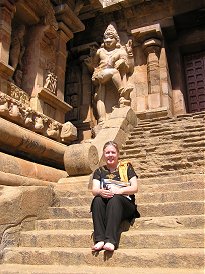 Everyone in this southern Indian village seems to accept the fact that if
someone wants to play loud music at 4 a.m., it’s perfectly all right.
Particularly in the days and weeks leading up to Pongal, the Indian harvest
festival on Jan. 16. The music is a call to prayer or at least a wake-up
call so households can prepare special meals or spend extra time at a temple.
Everyone in this southern Indian village seems to accept the fact that if
someone wants to play loud music at 4 a.m., it’s perfectly all right.
Particularly in the days and weeks leading up to Pongal, the Indian harvest
festival on Jan. 16. The music is a call to prayer or at least a wake-up
call so households can prepare special meals or spend extra time at a temple.
I adjusted my earplugs and went back to sleep. And after a few days, I didn’t notice the early-morning serenades. That was one adjustment I had to make to life in an Indian village – they can be noisy places.
I was in India with Koen Van Rompay of UC Davis, founder of the Davis-based Sahaya International www.sahaya.org and Sahaya board member Mirriam Rafiq, a UCD graduate and public health worker. We came to Andimadam to evaluate and monitor the results of an AIDS education grant, to visit the AIDS orphans sponsored by Sahaya members, and to visit a tiny village school we wanted to help rebuild.
I also wanted to meet members of our opposite number -- a non-profit called READ, Rural Education and Action Development -- which organizes self-help groups in the village and surrounding area to financially empower women.
The story goes that Van Rompay, an AIDS researcher, attended an international conference in Chennai in 1997. There he met D. Selvam, the Indian social worker who founded READ. The two men struck up a friendship; Selvam invited Van Rompay to visit his village and Van Rompay fell in love with rural India, which he liked much more than the chaos of India’s big cities.
Van Rompay later founded Sahaya (the word means “help” in Sanskrit) to funnel money and volunteers to his Indian counterpart.
Sahaya House
A year ago, Van Rompay decided to invest in the village by financing the construction of a guesthouse, which he and other volunteers could use on trips to Andimadam. It was hoped the guesthouse also would generate income for READ. But construction on the guesthouse slowed in November and December, stalled by heavy rains. We didn’t know what state it would be in when we arrived in mid-January.
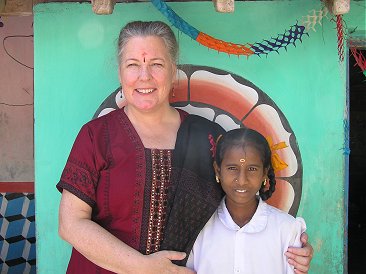 When Selvam met us at the Chennai airport, he told us not to worry about
accommodations but wouldn’t go into details. We spent one night in the city
at the YWCA and took the train to his village the next day. He told us that
he had two surprises for us.
When Selvam met us at the Chennai airport, he told us not to worry about
accommodations but wouldn’t go into details. We spent one night in the city
at the YWCA and took the train to his village the next day. He told us that
he had two surprises for us.
The next afternoon, after three hours on the train and two hours by car on bad roads, we jolted up to the guesthouse in Andimadam. The first surprise stood in front of us: the guesthouse was not only complete but we walked into a big party. The party was being held for us to inaugurate the opening of Sahaya House.
A throng of well-wishers from READ and the village welcomed us and soon dinner was served. We sat cross-legged on the floor eating fried bread and rice dishes off banana leaves.
The guesthouse was open but there was no furniture. Fortunately, in the middle of the party a delivery truck pulled up outside with all the beds. And the next day someone donated a table for the dining room.
Arranged marriage
During dinner, Selvam, 40, delivered the second surprise.
“I’m getting married,” he said. Further, he was marrying a woman he had not yet met. We were invited to the engagement party and the wedding, which would be held in a little more than two weeks.
While the idea of an arranged marriage might strike some people as an anathema, it is not uncommon in India and Selvam was entirely agreeable to it. He wanted to get married, had not found a suitable match on his own, and turned the problem over to a friend. The friend accepted the matchmaking charge and found a lovely young woman, Ammu, 31, from a good family about two hours away.
(I will skip ahead and say that both the engagement ceremony and the Hindu wedding – attended by 3,000 people -- was beautiful. When they finally met, Selvam and Ammu seemed to like each other enormously. The marriage engineered by family and friends has turned into a love match.)
The first week in India, Van Rompay and Rafiq worked on an AIDS education grant, while I was especially eager to visit a village school and meet the young boy I was sponsoring. His name is M. Vignesh and he’s going to be 11 on March 20, 2006. His father died when he was an infant and his mother ran away. He lives with his grandfather who runs a small teashop.
Meeting Vignesh
When Vignesh and I met at his school we shook hands formally. I am very happy to say that my small contribution of $30 a month is enabling him to stay in school. (If you would like to sponsor an AIDS orphan in this village, go to www.sahaya.org for more information.)
We played Frisbee with the kids at the school for almost an hour. It became evident that Vignesh was a leader, being one of the smartest and tallest boys in the school. He also is an incredibly sweet boy who later visited us at the guesthouse on several occasions.
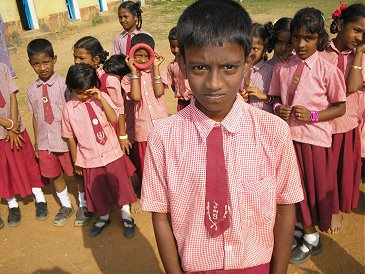 While many kids we met either begged us to take their pictures (“Photo,
photo!”) or pleaded with us to play catch with them (“Ball, ball!”),
Vignesh was polite and serious and never asked for anything.
While many kids we met either begged us to take their pictures (“Photo,
photo!”) or pleaded with us to play catch with them (“Ball, ball!”),
Vignesh was polite and serious and never asked for anything.
He spoke English carefully, thinking for a time before coming up with a complete sentence like: “What is your favorite color?”
Vignesh is an excellent student and a wonderful dancer who didn’t mind getting up in front of a crowd and showing us his moves. He wants to be a doctor and I applaud his ambition. But if he grows up to be a Bollywood dancer, that will be fine, too.
I gave him pencils, toys and stuffed animals but the gift he enjoyed the most was a book in English, “Around the World in 80 Days,” which thrilled him.
One afternoon, Van Rompay, Rafiq, Selvam and I visited Vignesh and his grandfather at the teashop. We drank milky coffee inside the dark shop but his aloof grandfather stood off to the side. I wondered if we had insulted him in some way. Then I saw tears in his eyes.
“I am only living for my grandson,” he said.
Dollars go a long way
A loan of 1,320 rupees or $30 can make a big difference in an Indian woman’s life. She can buy a goat or a pig or a new sari.
Van Rompay of Sahaya International works closely with a group in India that organizes self-help groups to empower women in Andimadam and the Perambular district in Tamil Nadu.
On our recent visit, we visited several self-help groups sponsored by our colleague, D. Selvam, and his organization READ, Rural Education and Action Development.
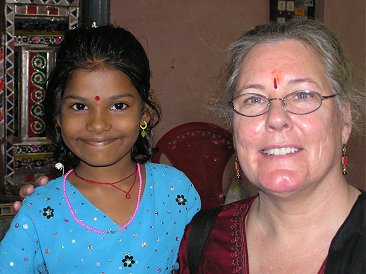 The women in the self-help groups meet on a regular basis to share
information and socialize. READ supplies low-interest loans to the group so
the women can start small businesses or borrow money for emergencies
without going into debt with a high-interest money-lender. Some of the
women we met borrowed money so they could begin to process locally grown
cashews in their homes as a cottage industry. Others opened small shops or
bought goats or sheep. One self-help group we visited had been together for
almost 10 years.
The women in the self-help groups meet on a regular basis to share
information and socialize. READ supplies low-interest loans to the group so
the women can start small businesses or borrow money for emergencies
without going into debt with a high-interest money-lender. Some of the
women we met borrowed money so they could begin to process locally grown
cashews in their homes as a cottage industry. Others opened small shops or
bought goats or sheep. One self-help group we visited had been together for
almost 10 years.
I asked the women what they used the extra money for.
“For a funeral,” said one woman. “For medical expenses,” said another. “For my children’s school,” said another woman.
The number of self-help groups in the area has grown in less than 10 years from one group to more than 1,000. The women in the groups also have been educated about AIDS – what it is and what it isn’t.
The women in the village dressed beautifully in silk or cotton saris and always wore fresh flowers in their hair. Even the female laborers wore saris. The saris are made locally -- weaving is a widespread business. From early in the morning until late at night you can hear the clack, clack of the looms.
The three of us visited the self-help groups, schools, and joined a party for the AIDS orphans sponsored by Sahaya members in Davis. We also visited an overcrowded village school, the Mother Teresa School, that we want to raise money to help rebuild. And I met a group of young women who earn money embroidering greeting cards that Sahaya sells at the Davis Farmers’ Market.
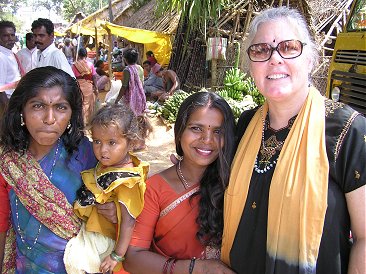 Southern India can be unbearably hot but in January and February the
temperature was perfect. Rafiq and I did not want to offend our hosts by
wearing shorts or sleeveless blouses nor did we want to wear saris. It’s
tricky to learn to fold the seven to nine yards of material that make up a
sari. Although Rafiq and I wore saris to Selvam’s wedding, we required
considerable help from our Indian sisters to get dressed.
Southern India can be unbearably hot but in January and February the
temperature was perfect. Rafiq and I did not want to offend our hosts by
wearing shorts or sleeveless blouses nor did we want to wear saris. It’s
tricky to learn to fold the seven to nine yards of material that make up a
sari. Although Rafiq and I wore saris to Selvam’s wedding, we required
considerable help from our Indian sisters to get dressed.
Instead, she and I opted to wear shalwar chemises. A shalwar chemise consists of a scarf, long tunic and long pants. We felt this represented a good compromise – definitely a modest, Indian-style of dressing but also easy for Westerners to wear.
When we weren’t visiting temples, schools or self-help groups, we spent time at Sahaya House, the guesthouse. We bought a badminton set that became a great draw for neighborhood children.
Adopting a puppy
One day a little puppy ran into the house while we were eating lunch. I adopted her on the spot. She was skinny and dirty and her ribs showed through her dusty brown coat but her ears were alert, her eyes were bright and she had a spot of white fur on her forehead just like the bindis Indian women place on their foreheads.
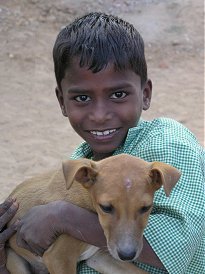 We named her Maxie and after a few weeks of table scraps she began to look
healthy. And she certainly was happy with her new friends. Most of the dogs
in the village were strays that belonged to no one and had to forage in the
garbage pits and fight for scraps of food. They were a skinny and mangy bunch.
We named her Maxie and after a few weeks of table scraps she began to look
healthy. And she certainly was happy with her new friends. Most of the dogs
in the village were strays that belonged to no one and had to forage in the
garbage pits and fight for scraps of food. They were a skinny and mangy bunch.
As Maxie grew bigger and more healthy, Van Rompay, who trained as a veterinarian, suggested that we find a vet to spay her.
“If not, she’ll have litter after litter and live a very short life,” said Van Rompay.
While our hosts at READ were eager to accommodate us in every way, we could never accomplish the task of getting the puppy spayed. It wasn’t at the top of anyone’s list of things to do. And there was no one in the village equipped to do it. If there were local vets, they were going to work on income-producing animals, not cats and dogs.
We realized that for the dog to get her operation we would have to pay a READ staff member to take Maxie by bus to an animal clinic in Chennai. He or she would have to stay overnight and bring the dog back the next day. And that kind of time and effort simply wouldn’t be put into a dog. There are HIV-positive children in the village who find it difficult to get to the hospital in Chennai for treatment so our concern about the dog was not taken seriously and we abandoned the project.
Educating gay men
On another day, the three of us went to the nearby town of Cuddalore, a city of 650,000, to visit one of READ’s satellite offices. We met with a group of volunteer outreach workers who concentrate on educating gay men about AIDS.
The READ office serves as a haven and drop-in center for these men, providing a place to watch movies, wear women’s clothing and be themselves.
They felt comfortable dressing in women’s clothing and dancing for us. They correctly assumed that we would be far more tolerant than their families.
Indeed, none of the men had come out of the closet. They lived at home with their parents but said their families would not tolerate a gay lifestyle.
One man said he would commit suicide rather than have his sexuality divulged. Another said his brother would douse him with kerosene, lock him in a room and burn him alive rather than let him live at home as an openly gay man.
The same man, a wine shop clerk, estimated that 25 percent of the men in Cuddalore have sex with men, but only 10 percent consider themselves gay.
Each said they knew two or three people who had died of AIDS.
“We are very careful now and use condoms,” the shop clerk said. “We know the importance of HIV education.”
Remembering India
When I think of India I see hundreds of snapshots in my head. I will always remember our visit with the gay men of Cuddalore. I see Selvam and Ammu at their wedding. I see Maxie the puppy playfully biting the legs of a bigger dog outside Sahaya House. I see 30 neighborhood children playing in the evenings outside the guesthouse and practicing their limited English on us. I see Vignesh in his school uniform reading aloud from his English book. I see the women who patiently helped me with my sari. I see the three ayahs who worked in the guesthouse cooking and cleaning for us. I see a leper begging outside the Andimadam Catholic Church. I see wild monkeys running across the road.
The morning we left Andimadam to return to Chennai and the United States, I turned around in the back seat of the car for a last glimpse of the guesthouse. The three ayahs were standing by the front door, crying. Maxie the puppy stopped pestering the bigger dog for a few seconds and stared at the departing car, ears cocked. It was a quiet morning; all the children were in school.
I wondered if I’d ever come back.
--Reach Elisabeth Sherwin at gizmo@dcn.org